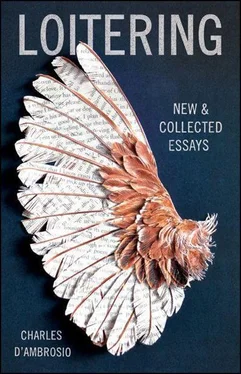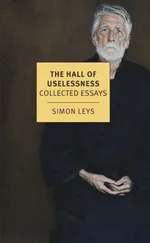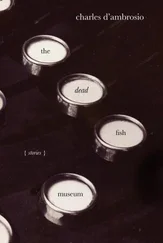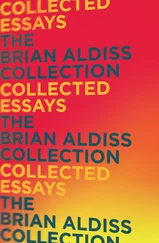In a windowed rotunda there’s a guy with a red feather duster dusting away at 7:00 AM. He doesn’t seem to come by dusting naturally; there’s a dispirited vo-tech or occupational therapy aspect to the way he does the job, a trained make-work quality, a lack of flair, especially when he starts dusting the walls. The walls! I keep watching and wondering what dust has fallen on this immaculate place in the night. It looks like he’s trying to catch the dust in flight, before it lands. Preventive dusting. I watch him wave the duster and I listen to the shoptalk of journalists. It sounds really important having this proximal relation to reality, living every day of your life as the next-door neighbor to the truth. After a while the courtroom opens and the big fish in the media pool are ushered in and seated so they’ll get the clearest view (camera angle) of Mary Kay Letourneau when the time comes. Myself, I’m seated right behind the family of the young man I’ll call X 1and who for legal and dramatic purposes the press has labeled a “boy” or a “child” or a “victim.” When Letourneau enters stage left and sits beside her lawyer, I have an obstructed view of the back of her head. At my age I’ve seen the backs of untold thousands of heads — more backs than fronts, probably — and note nothing particularly interesting to say about hers.
Mary Kay Letourneau dared to be unclear in public. “I wish,” she said, “there was a story that made sense and could be told right now, but there isn’t.” When she arrived in court for the sentencing she had a frail wispy etiolated look from having spent months in jail but otherwise her in-person face showed the same smudged and incoherent prettiness captured in countless pictures. I’d seen plenty of those photos in the papers and magazines and with each instance I wondered why her features weren’t in focus. But it turns out they were; it’s just that her face, even in real life, appears clouded and dreamy and somewhat removed from the immediate scene. Her lawyer, David Gehrke, characterized her as a woman with “a screw loose” who “doesn’t know how to separate reality and fantasy.” Her husband, Steve Letourneau, for some ulterior reason wanted everybody to know she was not Mary Poppins. In my experience the strategy a lot of frightened women turn to is that of making themselves intangible. Rather than go hard and confrontational the way a man in crisis might, they become ethereal and really remote. Based on no one’s authority but my own, I would say Letourneau showed the mien of a battered woman, of someone in retreat from her own face, whose safe haven is inward, reclusive, solitary, distant, and that what you saw in the pictures, in the photographed face the press captioned variously as belonging in an abstract allegoric uppercase way to a Wife, a Teacher, a Mother, was little more than a mask she’d vacated a long time ago.
She wasn’t clear. She insisted until she was silenced by lawyer Gehrke and pressured by the public call for a kowtowing show of remorse and civic obedience that her relationship with X was love. She said that “given the nature of this situation — and that includes the charges against me, the media, everything — there isn’t anything within legal bounds that I can say to help make sense of what is happening.” (My italics.) Against the chorus of experts who in one rote voice claimed her relationship with X was “distortion” and “manipulation” and “rationalization,” Letourneau said, “I would not expect people to understand, but it did exist and it was real.” She was never loose or gallionic about the gravity of her situation and her public statements always struck me as honest and unfiltered, a too frank, badly lawyered expression of confusion that rang true, not because she was successful in justifying or rationalizing her actions, but precisely because she was hesitant, uncertain, floundering — precisely because she failed, and failed publicly! She never told us what we wanted to hear. She wasn’t glib, she wasn’t corny, she never once deliberately lied or even delivered a pat, practiced answer. Given the boundaries she’d crossed and the taboos she’d broken and the generally undone state of her life, it’s incredible to me she was even able to speak at all. The story drew prurient attention locally and from around the country, and soon after that the experts moved in with their extra-strength vocabularies, the proficient idioms of the law, of social work, of psychology, but Letourneau alone seemed to have trouble finding words. You could hear in her voice and in the absence of cant that her true feelings, whatever they were, like Cordelia’s love, were more ponderous than her tongue.
Pretty much the opposite of Letourneau’s hesitance was the insta-commentary offered up by local broadcasters. After the sentencing one Bonnie Hart from KIRO or KOMO — I forget which and don’t believe it really matters — quickly convened a kind of radio Sanhedrin. As far as I know Hart’s only real qualification for commenting on Letourneau is that she holds a job that requires her to say something re: something most every day of the week. Day after day I suppose she’s paid to be fluent in politics, cookbooks, fresh vegetables, fads, open or closed batting stances, menopause, studded tires, whatever. In other words, her authority is mostly occupational, though it seems she’s possessed of omniscience. Her opinions weren’t suasive enough to win me over, not by any of the common measures I developed as a Catholic kid avidly listening for lame moments in hundreds of homilies. No elegance or force of thought, no wit, no keen insight, no revelatory moments that broadened perspectives, that enlivened feelings, no resonance, no self-scrutiny, no risk, no compassion or sympathy or anything close to eloquence. By the strident and aggressive tenor of the talk you couldn’t tell if this Bonnie Hart entertained any doubt, then or ever, she was so careful not to cross herself, so careful to arrange her moral outrage along the lines of least resistance. In a sense the whole program was about Hart rendering the round world flat and endorsing lopsidedness, halfness. This seemed a crude and retrogressive project, since what really distinguishes us from apes is not the opposable thumb but the ability to hold in mind opposing ideas, a distinction we should probably try to preserve.
But these days you get the impression people think it’s kind of recreant to waver, as if by feeling and expressing, or worst of all admitting, doubt and uncertainty, you’re being disloyal to a guiding idea. In the case of Mary Kay Letourneau it seemed to me that over the previous nine months what you had was the spectacle of this woman who’d been publicly knocked down, disgraced, humiliated, scorned, abandoned, who’d been imprisoned and made destitute, who’d lost everything, her family, her job, her house, her reputation, her freedom, her privacy, and even if I accepted the hardest line of the moral hard-liners, even allowing for the possibility that this “adulterous” and “abusive” woman deserved what she got, that her crimes were staggering and odious and the probationary sentence just handed down by Judge Linda Lau was too lenient, that didn’t stop me from feeling uncomfortable and real lonely as I listened to this brave and pharisaic Bonnie Hart, who from the safe defilade of her radio booth was basically bending over to pick up the first stone.
In a “situation” like this it’s worth considering why only the authorities, the experts, the credentialed explainers remain articulate. Anyone alive today has at his or her disposal ages of mental experience to draw upon, and yet we seem to trust and accept only the most recent orthodoxies, the latest theories, the newest and freshest ideas in the marketplace. I applaud this reliance on the red-hot and the new when it comes to landing airplanes or doing appendectomies. Elsewhere, however, it seems we’re just skimming the surface to locate the most recently revised version of ourselves — a tentative, experimental understanding. A long backward glance establishes pretty clearly what’s endured over time and also exposes a lot of discredited stuff that was once taken quite seriously. I’m not just talking about the obvious crackpots and charlatans, nor do I mean the briefly credible phrenologists and lobotomists and such, but rather the discarded, the outmoded, the no-longer tenable, like, say, the Ptolemaic astronomers and the reign of geocentrists that lasted a long two millennia. Even Marx and Freud, our last two great systematizers, show signs of wear and exhaustion after just a single century of application. Experts in every field hold holy models and systems, languages, understandings, that are themselves subject to challenge, revamping, innovation, further sectarian squabbles, and so the whole reeling thing bravely wobbles on, even under the administration of people whose intentions are of the highest order. They’re dedicated. They keep up. Offices around this city are right now jammed with journals, trade publications, notes for papers and lectures, a whirlwind schedule of symposia stretching out over the upcoming calendar year, whatever, but it’s not really possible (nor really desirable) to declare finality of understanding within a single discipline.
Читать дальше












